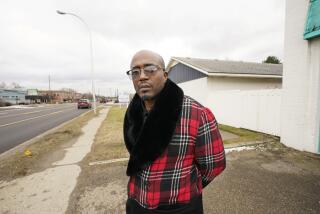Chicagoâs Gem of a Cop Opts for the Real Jewels
CHICAGO â The jewelry salesman was ready for the thieves this time. He set out on a trip with $58,000 in luxury watches in the trunk of his Lincoln. He wanted to be followed.
From his suburban Chicago home, he headed into Indiana as two cars--a Buick Century and an Olds Cutlass--trailed him for 50 miles, all the way to the parking lot of a place called the Spa restaurant.
When the salesman went inside, one of the thieves pounced--opening the trunk of the Lincoln with a key and lifting out two jewelry cases. Then he sped away.
This wasnât the first time the salesman had been targeted. Twelve years earlier, $310,000 in Baume & Mercier watches were snatched from his car--by some of the same thieves watching him this day.
But this time, the salesman was the bait. FBI agents in a van were videotaping the scene. And those watches lifted from the trunk? They were provided by the feds.
Among the thieves in Porter, Ind., that October day in 1996 was a lookout, a silver-haired man with an extraordinary resume for a criminal: He once was a deputy superintendent of the Chicago police.
As a cop, he had worked closely with the FBI, piling up commendations, including one from J. Edgar Hoover. He had such a legendary police career that Hollywood modeled a hard-boiled TV character after him.
But on this day, William Hanhardt was doing something far different:
He was running a multimillion-dollar jewel theft ring.
*
There was a time when Hanhardt was known as a copâs cop.
It was in the 1960s, an era when plainclothes police wore porkpie hats and reed-thin ties, that he began making his mark.
He once chased a vicious ring of home invaders down the street, his bravado making a front-page splash. A newspaper photo shows the young cop proudly holding a tommy gun.
âHe was a real hard-core guy--a guy who was really feared, even by his own squad,â says veteran private eye Ernie Rizzo.
Hanhardt waged war on burglary rings and cartage thieves who made off with televisions, cigarettes, anything that could be lifted off a trailer.
âHe had no peers in terms of his police career,â says Chuck Adamson, a former Chicago cop who wrote for the TV show âCrime Storyâ and a longtime Hanhardt friend.
In his heyday, Hanhardt headed the Central Investigations Unit, a handpicked team that targeted, among others, jewel thieves.
Over the decades, Hanhardt was rewarded with powerful posts: commander of the burglary section, chief of detectives, and one of a handful of deputy superintendents. He retired in 1986 as a captain.
As his 33-year career ended, Hanhardt became a consultant to âCrime Story,â a film-noir TV series about an elite team of Chicago detectives that takes on the mob.
Adamson says there was a lot of Hanhardt in the showâs hero, Lt. Mike Torello, a hard-living, make-his-own-rules guy played by actor Dennis Farina, a former Chicago cop himself.
The Torello character hailed from the near West Side neighborhood, âthe Patch,â where Hanhardt grew up--alongside a number of mob bosses.
The show seemed a case of art imitating life: There were stories about cartage heists, home invaders--even a jewel theft from a car trunk.
At some point in his glory years--decades ago--people started to whisper about Hanhardt.
âThe rumors were, âHow can a cop be so be great unless he had the inside track at something?â â Rizzo says. âHe would know who committed a score hours after it happened.â
Bob Fuesel, a retired Internal Revenue Service agent who worked on organized crime cases during the 1960s and â70s, says he was told by members of the police intelligence unit âto stay away from that guy.â
One longtime con said several years ago that in the 1960s, the word on the grapevine was that mobsters were paying the master detective $1,200 a month.
It didnât help when Hanhardt showed up in places a good cop doesnât belong: in the little black book of a murdered labor racketeer, on the witness stand for the defense in the Las Vegas jewelry burglary trial of reputed mobster Anthony âthe Antâ Spilotro.
Hanhardtâs lawyers dismiss the accusations as the words of lowlifes who held grudges.
Hanhardt defended his own record in an affidavit last year, saying he and others in his command arrested numerous mobsters.
Hanhardt has not spoken publicly since being charged, but in a 1995 interview with Richard Lindberg, author of several books on Chicago police and crime, he offered his perspective on life as a cop:
âYou knew that youâre going to get [cheated] eventually, so you went into the game with that thought in mind. . . . You got a wife. You got kids. So you got to think about the future, right? But I never liked thinking about the future. I liked to live for the moment.â
*
The FBI pursued Hanhardt with the same dogged detective work he might once have applauded. By 1996, a decade after he had retired, the government was wiretapping his home phone, recording hundreds of conversations.
The tapes revealed Hanhardt was calling police department contacts, who did database searches on jewelers.
The feds also obtained copies from an informant of index cards with information on jewelers used by Hanhardt and others to conduct surveillance.
Hanhardtâs doom may have been sealed in 1999 when an associate in the jewel theft ring got involved in a nasty divorce. The wife led Rizzo, the private eye, to a bank safe deposit box. It contained scores of uncut diamonds and jewels--plus a phony ID her husband had used, along with phone bugs and car-tracing beepers.
Word of the stash soon spilled out. And the FBI swooped in with subpoenas.
*
In the fall of 2000, Hanhardt and five other men--including the one involved in the divorce--were charged with operating a nationwide theft ring that stalked jewelry salespeople and stole more than $5 million in gems and watches.
One heist occurred near the end of Hanhardtâs career, the others after he retired.
Over 12 years, there were eight thefts and two attempts, including that 1996 incident in Indiana, involving the same salesman as in the Milwaukee job.
Snatching platinum and diamonds, watches, earrings and bracelets--most never recovered--the thieves had successful scores in Arizona, California, Michigan, Minnesota, Ohio, Texas and Wisconsin.
The biggest was a $1.5-million heist from safe-deposit boxes at the Columbus, Ohio, Hyatt Regency hotel.
Federal officials say the group stalked more than 100 jewelry salespeople handling more than $40 million in merchandise over 15 years.
The thieves used coded language and aliases, carried lock picks and listening devices and kept meticulous records on potential targets.
They convinced auto manufacturers they were dealers to get access codes to cut new keys for cars.
And they bought luggage that matched bags carried by their targets, so they could make a quick switch.
Last October, a day before Hanhardt was to plead guilty to transporting stolen property across state lines and racketeering conspiracy charges, he overdosed on pain pills in an apparent suicide attempt.
About a week later, the man who once wore a neatly pressed blue uniform, appeared in court in an orange jumpsuit:
âAre you pleading guilty because you are, in fact, guilty?â the judge asked.
âYes, sir, I am,â he replied.
*
William Hanhardt is set to be sentenced April 29. He faces up to 25 years in prison, although attorneys have suggested that federal guidelines could make it closer to 12 years. That could be a life sentence for Hanhardt, who at 73 has survived a bout with cancer and has other health problems.
In his plea, Hanhardt admitted to few specifics but acknowledged participating in some thefts. Four co-defendants, some with lengthy mob associations, also have pleaded guilty and all but one identified him as the ringleader.
It is an ignominious ending to a once-celebrated career.
And Lindberg, the author, has a theory about why it happened:
âI think he did it because of the rush,â he says. âPeople working inside the system believe that theyâre outside the rules of the game. . . . Iâm certain Hanhardt believe[d] that he was never going to get caught. . . . Itâs Chicago--and as they say in Chicago, anything goes.â
More to Read
Sign up for Essential California
The most important California stories and recommendations in your inbox every morning.
You may occasionally receive promotional content from the Los Angeles Times.










